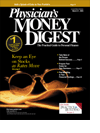Use of Prescription Drugs Growing
Arecent report from the National Center for Health Statistics (NCHS; www.cdc.gov/nchs) shows that Americans are increasingly reliant on prescription drugs to maintain their health. According to the report, nearly 45% of Americans take at least one prescription drug and 17% take three or more.
As the contents in our medicine chests expand, total spending on health care is skyrocketing. Health care costs were up 9.3% to $1.6 trillion in 2002, the last full year covered by the report, and about 10% of that money went for prescription drugs. Since 1995, spending on prescription drugs has climbed faster than any other segment of the health care industry.
The marked rise in prescription drug use can be traced to several factors, according to the report, including clinical guidelines that increasingly call for drug therapy to treat a broad spectrum of chronic conditions such as hypertension, diabetes, and elevated cholesterol. The growth in the number of Americans covered by medical insurance and the discovery and marketing of several new drugs are also part of the picture.
Leading the Pack
Two categories of drugs (ie, statins and antidepressants) were responsible for much of the growth in prescription medication use. The use of antidepressants by adults tripled in little more than a decade, while the use of cholesterol fighting statin drugs, which include the top-sellers Lipitor and Zocor, tripled between 1995 and 2002.
There was also a significant variation in the use of prescription drugs between men and women. Nearly half of all women take prescription drugs, compared with 39% of men. And although one in 10 women reported using antidepressants, only 4% of men did. The statistics tell a different story, however, when it comes to statin drugs. Although the incidence of high cholesterol in women is just as likely as in men of the same age, men aged 65 and older were 25% more likely to be on cholesterol lowering statins.
The number of prescriptions for some drugs prescribed to children also showed differences based on gender. For example, boys who visited a physician's office or clinic were much more likely than girls who visited a physician's office or clinic to be given a prescription for drugs in cases of attention deficit hyperactivity disorder. In fact, from 2000 to 2002, boys between the ages of 5 and 17 averaged 13.5 doctor visits per 100 boys and girls averaged only 5.3 visits. On the other hand, although antidepressant use among all children was up sharply, they were prescribed at similar rates for both boys and girls.
Does Therapy Work?
Proponents' argument:
Proponents of drug therapy have long contended that prescription drugs, despite their rising costs, can be a way to control overall health care expenses. Prescription drugs often reduce the need for expensive surgery and hospitalization and prove to be an effective method for treating disease.
Some statistics from the NCHS report appear to give support to this hypothesis. These statistics show that, as prescription drug therapy has risen, there has been a decrease in the death rate from conditions such as heart disease. The report notes that the long-term trend in deaths from heart conditions continued to lower in 2002, with the death rate from heart disease dropping another 3%.
